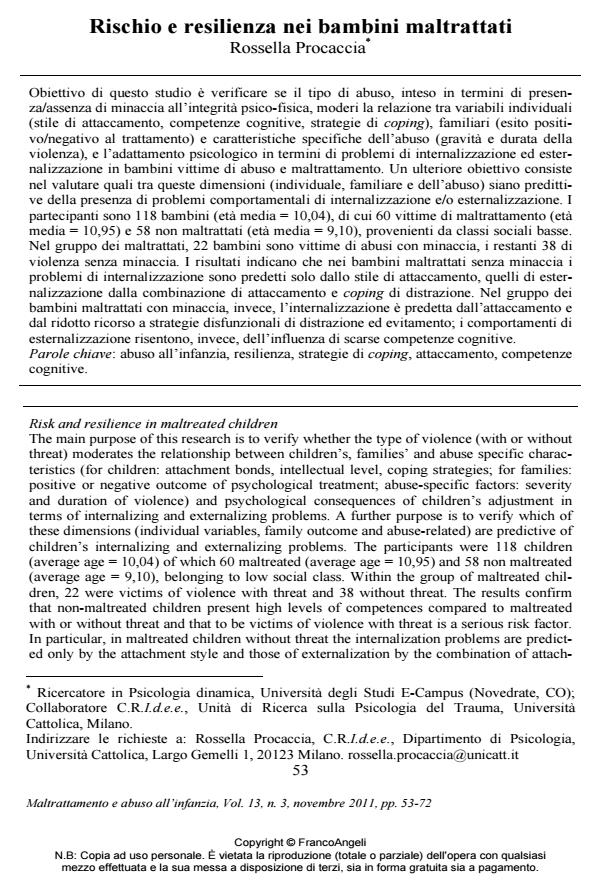Risk and resilience in maltreated children
Journal title MALTRATTAMENTO E ABUSO ALL’INFANZIA
Author/s Rossella Procaccia
Publishing Year 2011 Issue 2011/3
Language Italian Pages 20 P. 53-72 File size 813 KB
DOI 10.3280/MAL2011-003004
DOI is like a bar code for intellectual property: to have more infomation
click here
Below, you can see the article first page
If you want to buy this article in PDF format, you can do it, following the instructions to buy download credits

FrancoAngeli is member of Publishers International Linking Association, Inc (PILA), a not-for-profit association which run the CrossRef service enabling links to and from online scholarly content.
The main purpose of this research is to verify whether the type of violence (with or without threat) moderates the relationship between children’s, families’ and abuse specific characteristics (for children: attachment bonds, intellectual level, coping strategies; for families: positive or negative outcome of psychological treatment; abuse-specific factors: severity and duration of violence) and psychological consequences of children’s adjustment in terms of internalizing and externalizing problems. A further purpose is to verify which of these dimensions (individual variables, family outcome and abuse-related) are predictive of children’s internalizing and externalizing problems. The participants were 118 children (average age = 10,04) of which 60 maltreated (average age = 10,95) and 58 non maltreated (average age = 9,10), belonging to low social class. Within the group of maltreated children, 22 were victims of violence with threat and 38 without threat. The results confirm that non-maltreated children present high levels of competences compared to maltreated with or without threat and that to be victims of violence with threat is a serious risk factor. In particular, in maltreated children without threat the internalization problems are predicted only by the attachment style and those of externalization by the combination of attach- ment and distraction coping. In children who were victims of violence with threat, the internalization problems are predicted by attachment and by dysfunctional coping strategies of distraction and avoidance. In these children cognitive functioning is an important risk factor for externalization problems.
Keywords: Child abuse, resilience, coping strategies, attachment, cognitive level
- Does resilience mediate the association between mental health symptoms and linguistic markers of trauma processing? Analyzing the narratives of women survivors of intimate partner violence Marco Castiglioni, Cristina Liviana Caldiroli, Gian Mauro Manzoni, Rossella Procaccia, in Frontiers in Psychology 1211022/2023
DOI: 10.3389/fpsyg.2023.1211022 - Correlati neuropsicologici e di neuroimaging del maltrattamento e dell'abuso infantili Marco Cavallo, Arianna Signorino, in MALTRATTAMENTO E ABUSO ALL'INFANZIA 3/2015 pp.11
DOI: 10.3280/MAL2015-003002
Rossella Procaccia, Rischio e resilienza nei bambini maltrattati in "MALTRATTAMENTO E ABUSO ALL’INFANZIA" 3/2011, pp 53-72, DOI: 10.3280/MAL2011-003004